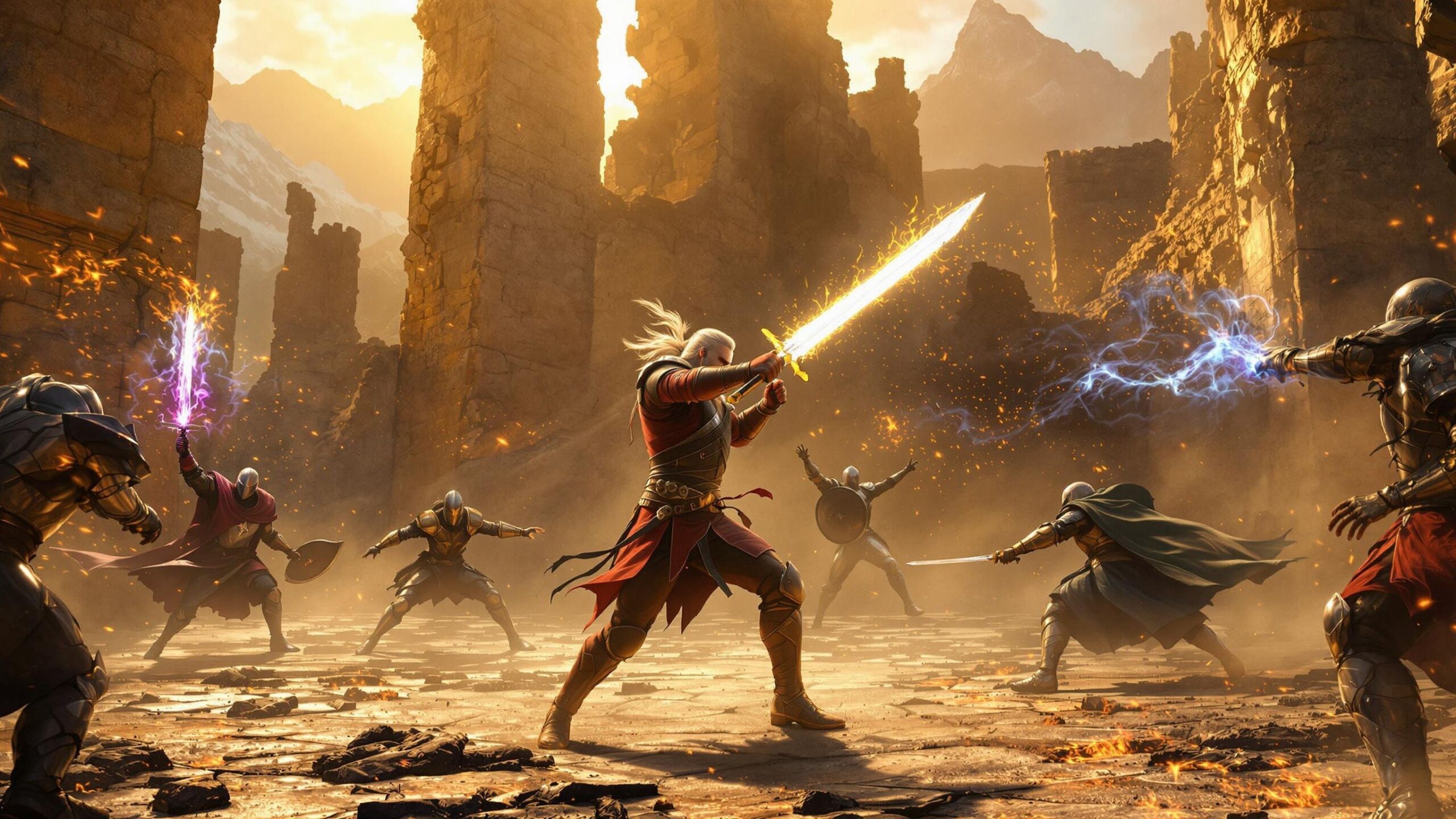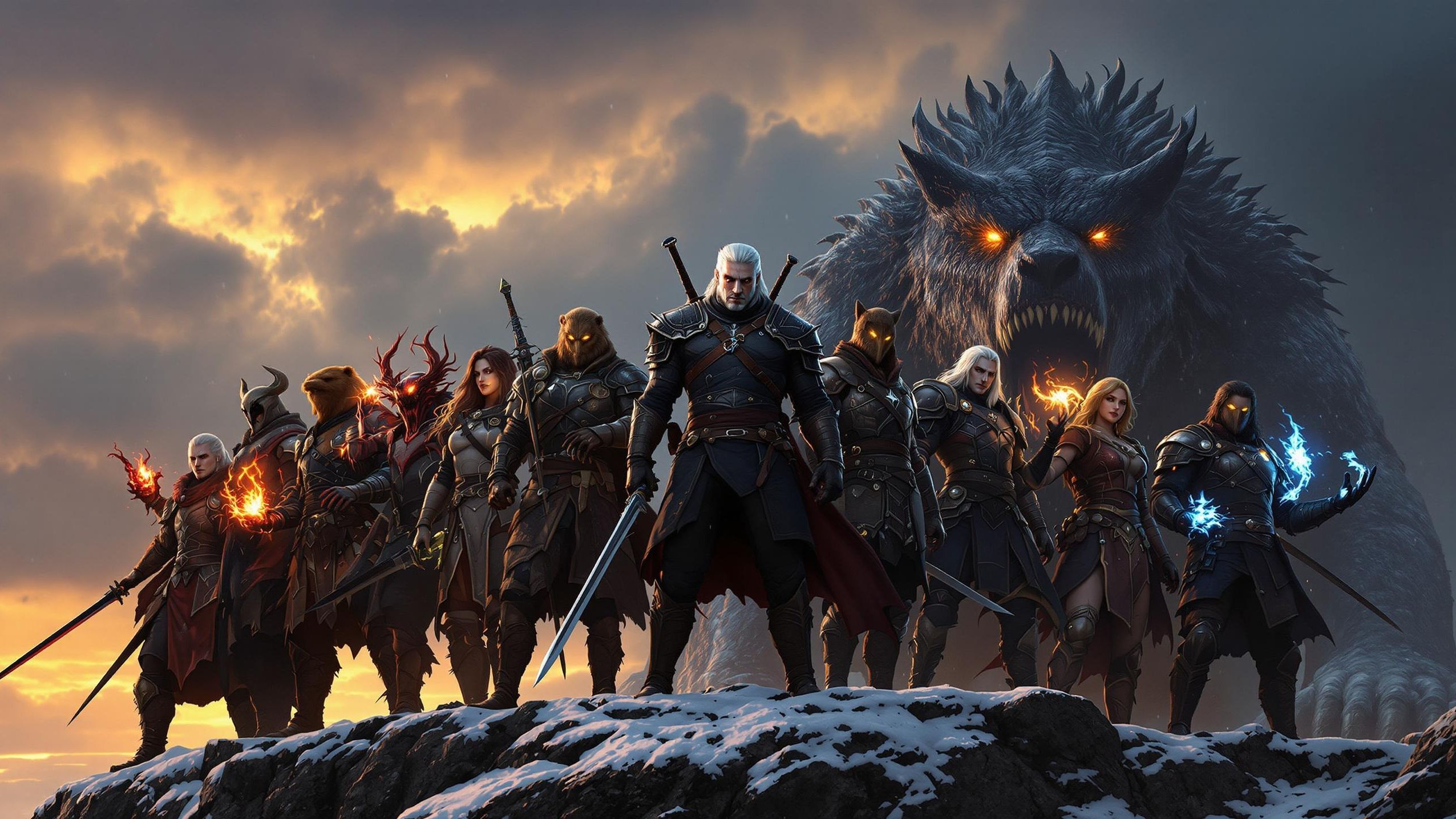Monster hunting is more than just a profession in The Witcher universe—it’s a bloody art form that tests the limits of both physical endurance and moral resolve. While Witchers are trained from childhood to fight and kill the horrors that stalk the world, not every contract is clean or simple. The most brutal monster hunts often demand more than skill with a sword—they demand sacrifice, cunning, and the willingness to face the darkest parts of humanity itself. These ten monster hunts from across the books, games, and Netflix series are unforgettable not just for their gore or difficulty, but for the emotional, ethical, and psychological toll they take on Geralt and the world around him.
#10: The Bruxa in “A Night to Remember” (The Witcher 3)
This hunt is a masterclass in horror and suspense. In The Witcher 3: Blood and Wine, Geralt tracks down a Bruxa—a higher vampire known for her terrifying screeches and agility—within a dimly lit mansion. From the moment Geralt enters the estate, the atmosphere is thick with dread. The Bruxa’s inhuman movement, her eerie voice, and the knowledge that she can become invisible at will turn the encounter into a chilling game of cat and mouse. The brutality of the fight is heightened by the fact that Geralt must rely on keen instincts and well-timed signs like Yrden to even see her. Unlike most monsters, Bruxae retain a disturbing level of sentience and charm. This one taunt Geralt, luring him deeper into her lair before unleashing an assault of claws, shrieks, and blood. It’s one of the most intimate, terrifying, and vicious fights in the franchise—and a reminder that not all monsters look monstrous.
#9: The Botchling from “Family Matters” (The Witcher 3)
Perhaps the most emotionally disturbing hunt in the series, the botchling is a grotesque, cursed creature born from the improper burial of a stillborn child. In The Witcher 3, Geralt is hired to investigate the Baron’s missing family, only to discover that the Baron and his wife had tried to hide their shame by burying their child in secret. The result is a monster fueled by pain and neglect. Geralt has two options: destroy it in a gruesome fight or attempt a ritual to transform it into a protective spirit. Either choice is brutal. The first path leads to a nightmarish brawl with a creature whose every cry is tinged with sorrow. The second path is quieter but emotionally devastating. This hunt is brutal not because of the blood spilled, but because of the moral weight. It asks what makes a monster—and forces Geralt to reckon with grief, guilt, and humanity’s darkness.
#8: The Leshen in the Whispering Hillock
The Leshen is one of the most iconic and terrifying monsters in The Witcher lore. Towering and antlered, with control over crows, roots, and the forest itself, a Leshen is no mere beast—it’s an ancient force of nature. In The Witcher 3, the Whispering Hillock quest introduces Geralt to one of the most brutal dilemmas in his career. The creature has been imprisoned beneath a tree and claims to be a spirit wronged by local villagers. Geralt must decide whether to free it and risk the wrath it might bring or slay it at the villagers’ request. The battle, should it occur, is pure brutality—roots tear from the earth, trees strike like whips, and the Leshen’s teleportation makes it hard to pin down. Whether Geralt chooses to fight it or let it go, the consequences are bloody. This hunt isn’t just physically punishing—it’s a masterclass in how brutality can be both moral and monstrous.
#7: The Striga from “The Witcher” (Books and Netflix Series)
One of Geralt’s most legendary hunts, the Striga is a child cursed into monstrous form due to political betrayal and incest. Locked in a sarcophagus by night and turned into a ravenous beast by moonlight, she haunts the crypts of Temeria. In both the original short story and its television adaptation, Geralt doesn’t try to kill the Striga—he tries to save her. But to do so, he must survive a night locked inside her lair, enduring savage attacks with no room to breathe. The brutality is unmatched: claws rip through armor, blood spatters stone, and Geralt is nearly torn apart. But the emotional weight is even heavier—this is a child, twisted by a curse not of her own making. Geralt’s commitment to redemption over extermination turns this brutal encounter into one of the saga’s most iconic moral standpoints.
#6: The Hym in “Possession” (The Witcher 3)
The Hym isn’t a monster you can fight with a sword—at least not directly. It’s a malevolent spirit that feeds on guilt, driving its hosts to madness and suicide. In the Possession quest, Geralt is asked to help a young noblewoman whose fiancé, Udalryk, is being haunted by a Hym after making a terrible decision involving his brother’s death. The Hym manifests as a shadowy presence, whispering guilt into Udalryk’s mind. The clever twist is that Geralt can’t defeat it through combat. Instead, he must either trick the Hym into revealing itself by staging a fake murder or allow Cerys to perform a risky ritual. This hunt is brutal in a psychological sense—it preys on trauma, using emotion as a weapon. Geralt’s role isn’t just to slay a beast, but to become a performer, a manipulator, and a spiritual guide. It’s a mind-bending encounter, and one of the franchise’s darkest, most inventive stories.
#5: The Chort in “Contract: Lord of the Wood” (The Witcher 3)
This brutal contract in The Witcher 3 takes Geralt into the wilderness to investigate a string of grisly murders near a remote village. The culprit turns out to be a chort—a massive, horned beast similar to a fiend, but faster and more aggressive. The fight is a relentless, gory slugfest in the middle of dense woods, with the chort using surprise charges, earth-shaking stomps, and headbutts that can send Geralt flying. What makes this hunt especially brutal isn’t just the strength of the monster, but the isolation. There are no allies, no help—just Geralt, his steel, and a monster with an appetite for flesh. The fight demands constant movement, smart use of Quen for protection, and deadly precision. The tension doesn’t let up until the chort falls—covered in blood, breathing smoke—and even then, it leaves behind a grim reminder of nature’s worst horrors. The brutality is raw, primal, and unforgettable.
#4: The Toad Prince in Oxenfurt Sewers (The Witcher 3: Hearts of Stone)
When Geralt descends into the Oxenfurt sewers to investigate rumors of a deadly beast, he doesn’t expect to face a monstrous toad the size of a horse. But the Toad Prince is no fairy tale—he’s a cursed Ofieri prince, bloated and diseased, oozing poison with every movement. The battle takes place in an enclosed, filthy chamber where footing is unreliable and visibility is poor. The Toad spews acid, leaps with terrifying speed, and lashes out with its massive tongue. It’s a grotesque and exhausting fight that punishes every misstep. But the real twist comes after the battle, when Geralt realizes that killing the beast has triggered a political crisis with the Ofieri Empire, and he’s arrested for murder. The brutality here is twofold: physical devastation in battle, and the fallout of killing something that wasn’t just a monster, but a man trapped in a horrific form. Few contracts go as wrong—or end as painfully—as this one.
#3: The Fiend in the Forest of the Missing
Fiends are among the most terrifying creatures in The Witcher bestiary. Standing taller than a horse with a single third eye on their forehead, these monsters blend brute strength with hypnotic magic. In the Forest of the Missing quest, Geralt hunts a particularly deadly fiend that has been luring villagers to their deaths. The encounter is brutal from the first moment—ambushes, illusions, and brutal melee attacks combine to make it one of the hardest optional hunts in the game. The fiend’s ability to momentarily blind Geralt using its third eye adds a unique psychological edge, forcing players to rely on hearing and instinct. The setting—a quiet, sun-dappled forest—contrasts hauntingly with the monster’s brutality, enhancing the horror. This hunt captures everything The Witcher does best: danger, mystery, and the ever-present question of what separates beasts from men.
#2: The Crones and the Tree Spirit (The Witcher 3: Ladies of the Wood)
The intertwining quests involving the Crones of Crookback Bog and the Whispering Hillock offer one of the most morally complex and brutal hunts in the franchise. Geralt must choose whether to free a mysterious, imprisoned forest spirit—claimed to be an ancient defender of the land—or leave it to be destroyed, depending on the Crones’ wishes. If he chooses to fight it, the spirit unleashes a terrifying assault using roots, illusions, and poison. If he releases it, the spirit exacts horrific revenge on nearby innocents. Either way, Geralt is forced to confront an evil that cannot be cleanly defeated. The Crones themselves are grotesque, ancient witches who feast on children and manipulate local villagers with fear and magic. Later confrontations with them—particularly if Geralt faces them head-on—become blood-soaked showdowns filled with twisted imagery and nightmarish violence. This hunt isn’t just about death—it’s about the loss of innocence and the grim cost of every decision.
#1: The Wild Hunt’s Final Attack at Kaer Morhen
While technically more of a battle than a single hunt, Geralt’s defense of Kaer Morhen from the Wild Hunt is one of the most brutal and emotionally resonant moments in the entire saga. Eredin’s spectral army brings with it apocalyptic cold and death, forcing Geralt, Yennefer, Triss, and every surviving Witcher to make a last stand at their ancient fortress. The battle is long, chaotic, and merciless. Wraiths slice through stone, portals tear open the sky, and allies fall one by one. Vesemir’s death—heartbreaking and raw—marks the emotional peak of the conflict. Geralt fights not just monsters, but despair. Every sign cast, every sword swing, is fueled by love and fury. The brutality isn’t just physical—it’s the destruction of history, the burning of home, and the realization that the world they’re fighting for may not survive the war. Yet in this blood-drenched finale, Geralt stands tall, a symbol of resilience and sacrifice. It is, without question, the most brutal monster hunt—not because of the body count, but because of the price.
Brutality in The Witcher isn’t defined solely by how many limbs are lost or how grotesque the enemy appears. The most brutal monster hunts leave scars on the soul, not just the body. They force Geralt—and players—to confront moral ambiguity, loss, grief, and the darkness that festers not just in beasts, but in people. These ten hunts remind us that monsters are everywhere, and sometimes, the most dangerous ones wear familiar faces. In a world where every battle could be your last, the true mark of a Witcher isn’t that he survives—but that he endures.




